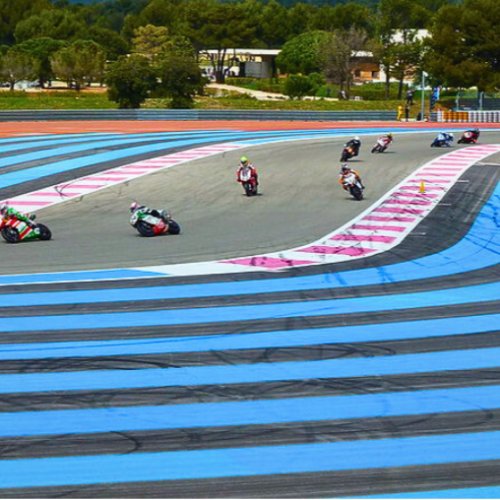The Bol d’Or: The Origin of Motorcycle Endurance Racing
The Bol d’Or is one of the greatest motorcycle endurance events in the world. Held each year at the legendary Circuit Paul Ricard in Le Castellet, in the southeast of France, this 24-hour race is an unmissable fixture of the FIM EWC World Championship. It brings together the best international teams in a challenge combining speed, strategy, and endurance.
🏍️The History of a Legend
Created in 1922, the Bol d’Or is the oldest of motorcycle endurance races. Each team—often made up of riders from around the globe—fields three riders who alternate over 24 hours to cover between 3,000 and 5,000 kilometers—equivalent to a round trip from Paris to Moscow!
Among the noteworthy figures in recent years are: the Spaniard Xavi Forés, a champion of consistency, who played a key role in Team BMW Motorrad’s victory in 2023; the Frenchman Mike Di Meglio, 2018 endurance world champion, is a pillar of the discipline, known for fluid and strategic riding; and the Japanese Yuki Takahashi, former Moto2 rider, embodies the growing strength of Asian riders on the European stage, having achieved several podiums at the Bol d’Or.
This sporting and cultural mixing gives the race a global and exciting dimension.

The event has had two interruptions: during World War II (1940–1946), and between 1961 and 1968. Its return to the Circuit Paul Ricard in 2015 marked a turning point, with record attendance and a full modernization of the event. This circuit, become a convergence point for teams and international fans, remains the historical epicenter of the race, with more than 30 editions held there and a confirmed contract until 2029.
Beyond the competition, the atmosphere is unique and unifying: concerts, entertainment, exhibitions, motorcycle village… The Bol d’Or is much more than a race; it is a true international festival of motorcycle culture, where all nationalities vibrate to the sound of engines.
For spectators, this event becomes a space of exchange. In campsites or the paddock, you hear French, Italian, German, Dutch … and conversations about bikes often become opportunities for encounters between enthusiasts, beyond language barriers. These spontaneous interactions illustrate perfectly the spirit of international exchange: shared curiosity, improvised conversations, and sometimes even lasting friendships woven… thanks to the motorcycle.
🏁 The Circuit Paul Ricard, an Icon of Motorsport
Located at Le Castellet, in the Var department, the Circuit Paul Ricard was inaugurated in 1970 by its namesake industrialist. Designed from the start as a model of safety and innovation, it has established itself as one of the most emblematic circuits in Europe.
It has hosted many disciplines:
- Formula 1 (French Grand Prix until 2022)
- Bol d’Or
- GT World Challenge Europe
- European Le Mans Series
- Truck races, cycling events, and even running races
Its unique visual identity, with blue and red stripes at the edges of the track, is no accident. Replacing traditional gravel traps, these colored zones are designed to slow vehicles in the event of a track exit, thus limiting crashes and mechanical damage. This system is now a worldwide reference in terms of safety.
The circuit is also prized by manufacturers for their marketing campaigns—as testified by Suzuki, which shot the advertisement of its new sports model there in 2025. Among its remarkable features is the famous Mistral straight, 1,800 meters long, where bikes and cars can exceed 300 km/h. Guaranteed thrills for riders… as for spectators.
💡 Precision Strategy
Here, performance depends on much more than speed. It’s a matter of strategy, mechanical management, and human endurance.
Each team has only one motorcycle for the entire duration of the race, making every decision crucial: tire choice, relay pace, fuel consumption, managing pit stops…
The riders—three per team—take turns every 45 minutes to an hour, depending on racing conditions. The mechanics, meanwhile, must intervene with formidable efficiency to refuel or repair the machine in as little time as possible.
Strategies can vary according to the technical cultures of manufacturers. Japanese firms (Honda, Yamaha, Suzuki, Kawasaki) historically favor long-term reliability, with bikes built to endure hours of running without weakening. Their teams often adopt a methodical approach, betting on consistency of relays and minimizing interventions during the race.
In contrast, European manufacturers, like BMW (Germany) or Ducati (Italy, more recently involved in endurance), develop highly performing, sharpened machines, sometimes at the cost of more demanding maintenance. Their strategy often relies on a higher average speed, with more aggressive relays and more refined tire and fuel management.
French teams, such as SRC Kawasaki, stand out by their field experience, their capacity to improvise in real time, and excellent knowledge of European circuits—an asset in case of changing weather.
The absence of a backup bike makes mechanical reliability vital. The best teams base themselves on consistency, perfect coordination, and anticipation of the unexpected. The Bol d’Or is rarely won by a flash move, but almost always by a strategy thought out in every detail.
🌏An Event of International Impact
The Bol d’Or attracts every year spectators from all over France, but also from Germany, Belgium, Switzerland, Italy, or Spain. The passion for motorcycles transcends borders: according to organizers, almost half of visitors arrive by bike.
Many travel several hundreds of kilometers to reach Le Castellet, turning the journey into a true motorcycle pilgrimage. In 2022, the event set a record with 82,000 spectators over three days.
The roads leading to the circuit become a spectacle in themselves, animated by bike parades and festive gatherings. Some motorcyclists organize road trips especially for the occasion, with bivouacs, rider meetups, and moments of conviviality.
It is not just a race: it is a human and collective adventure that begins long before the first lap.
At Kinder Exchange, we know that sharing a day or even a weekend in a wild, passionate atmosphere can forge new friendships and create memories for life.
Written by Loïc Ham and translate by Marie Baudet
